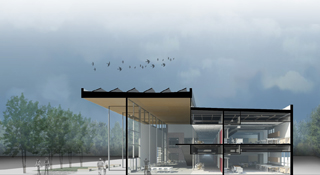|
Subscribe / Renew |
|
|
Contact Us |
|
| ► Subscribe to our Free Weekly Newsletter | |
| home | Welcome, sign in or click here to subscribe. | login |
Construction
| |
 |
August 25, 2011
Designing schools for tomorrow’s scientists and engineers
Integrus Architecture

Carter
|
It seems everywhere we turn these days, we hear about “STEM” school models developing in our public school districts around Puget Sound and across Washington state. STEM, which stands for science, technology, engineering and math, represents a growing movement to refocus the nation’s attention in curriculum areas that have seen steep declines in test scores and success rates.
The STEM movement is, at least in part, a reaction to the private sector’s unfilled demand for scientists and engineers, and the need to attract more women and minorities into STEM-related fields.
A 2010 report from the U.S. President’s Council of Advisors on Science and Technology envisions a two-pronged strategy for transforming K-12 education around STEM: Prepare students so they have a strong foundation in STEM subjects and are able to use the knowledge in their lives, and inspire students so that all are motivated to study STEM subjects.
The report recommends that the federal government help fund and create 1,000 new STEM-focused schools across the nation over the next decade.
Flexible spaces
Many school districts in Washington are adopting a STEM approach into their portfolio of education programs, both for existing science or career/technical programs, or as alternative, or “choice,” programs. Because the idea is relatively new, most STEM programs are making do with existing school facilities or developing partnerships to occupy existing space at their local community college.
There are several districts, however, that are designing new facilities specifically for their STEM programs, offering exciting opportunities for school planning and exploration. Lake Washington School District plans to open a STEM Choice program in the fall of 2012 in a new facility designed to be highly flexible. Bellevue School District’s Sammamish High School has received a grant for more than $4 million from the U.S. Department of Education to apply a STEM curriculum and methodology across its entire course platform.
While STEM is a relatively new idea as a curriculum model, much of its underlying themes are supported by education delivery that has been explored for several years.
STEM programs emphasize the use of technology, critical thinking over rote memorization of facts, and problem-solving assignments that discourage the traditional department-centric comprehensive high school model. The spaces needed to support these themes are very different from a traditional high school classroom.
Teachers in a STEM program act less as givers of knowledge and more as learning coaches. Since much of human knowledge is readily available to each student online, resources in STEM facilities are distributed to ensure that each student can access that knowledge and be provided an environment in which to use it. Space traditionally allocated to computer labs can be redistributed to create smaller, more flexible team collaboration areas.
Traditional library spaces also are being transformed, as their primary use is evolving away from simply warehousing knowledge (books), and towards being important public spaces that can accommodate learning through “information surfing.” Less storage is needed, and more space can be directed towards areas appropriate for team and individual study.
Fabrication spaces in STEM schools are transforming the nature of traditional vocational education programs. Rather than emphasize development of a craft or trade such as carpentry in a wood shop class, STEM students develop critical thinking skills in a problem-based assignment by identifying the problem, then designing, engineering and fabricating an appropriate solution.
Spaces to accommodate STEM fabrication assignments include a need for “clean” space, with computer access for engineering and drawing, as well as “dirty” space for active product fabrication. Although applications for new STEM fabrication spaces are almost limitless, many programs favor energy-themed assignments, such as development and fabrication of an electric vehicle.
Problem-based assignments, which require teaming, collaboration and cross-disciplinary work, demand a broader vision for spaces than previously accommodated in the public realm. With more and more of the students’ workday activities being performed outside the traditional classroom, public spaces must provide opportunities beyond circulation and storage. The new public realm in a STEM environment promotes performance and display of work, two important components to a student’s learning cycle.
Decentralized learning
Traditional classroom settings also are transforming to accommodate a decentralized delivery model.
Individual and small-group learning can occur throughout the classroom, with students oriented towards others in their group, or towards simulated lab interfaces, with the teacher roaming the space and acting as an advisor. This layout has profound implications for how we have traditionally thought about teaching walls, storage walls, and power and data access.
With its emphasis on problem solving, critical thinking and team collaboration, the STEM curriculum is ideally suited to encourage professionalism and to introduce professional mentoring to students.
This shift has strategic implications for design of new facilities. Many STEM schools are expecting significant numbers of mentors, each arriving daily to participate in school team activities.
Mentoring from outside professionals affects school entry, parking and wayfinding for existing school buildings that were largely designed to accommodate the majority of auto and pedestrian circulation at two “rush hours” during the day.
Professional mentors also need to be able to contribute to the school session without losing touch with their day jobs. To accommodate them, several STEM facilities are designing mentor offices. These semi-private spaces provide mentors with a place to take a private call or work one-on-one with a student while remaining visually connected to public spaces, promoting a safe and secure environment.
Furniture in a STEM facility is highly flexible. In several schools students are given their own workstations, like in a professional work environment, to serve as their home base as they work on assignments.
As the STEM movement does its part to transform education for our future generations of learners, school planners and designers have a fantastic opportunity to further explore how the spaces they create support innovative learning and create new and exciting opportunities for the people they serve.
Brian Carter is a principal with Integrus Architecture, a full-service professional services firm providing a broad range of services for higher education, K-12, civic/government and commercial clients throughout the world.
Other Stories:
- It’s time for Americans to rethink the classroom
- New schools are shelving the old library
- Historic schools: Restore or replace?
- Boom times at Boise State
- Induction systems can cut school HVAC costs
- How technology is reshaping the way students learn
- What I’ve learned after 15 years of designing schools
- Tacoma elementary turns to Montessori to attract students



